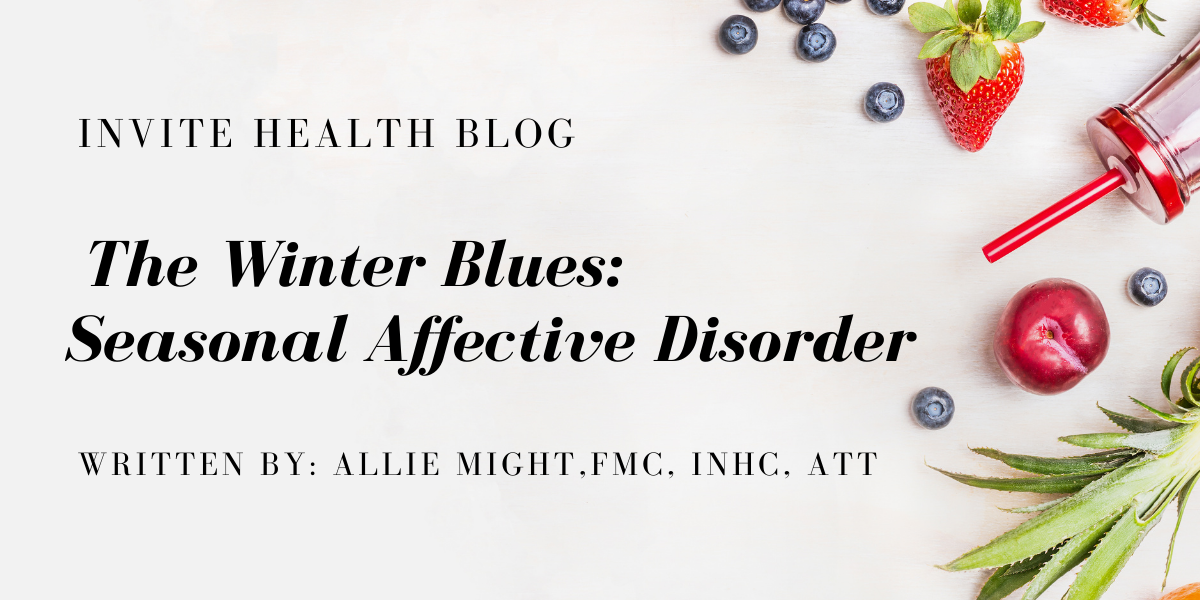THE WINTER BLUES: SEASONAL AFFECTIVE DISORDER

Written By: Allie Might, FMC, INHC, ATT
For further questions or concerns email me at amight@invitehealth.com
During the winter months, there always seems to be a “mood” in the air. We often hear people talk about “cabin fever” or “the winter blues”. But what do these really mean? Are they actual things to be more conscience of or are they just phrases that are used during these cold, winter months?
The terms “cabin fever” and “winter blues” are theoretically interchangeable.
While they are often terms used to refer for something called Seasonal Affective Disorder (SAD), which is a seasonal depression, they are a milder version of SAD. The Mayo Clinic defines SAD as a type of depression that occurs as the seasons change. This can begin in the fall as the weather starts shifting to colder temperatures and carries through the cold winter months. As the warmer spring and summer seasons approach, season affective disorder typically starts to “go away” and thus one starts to “feel better”.
What is it that can trigger seasonal affective disorder in some, but not others? According to Johns Hopkins Medicine, there can be a number of factors. As the days are shorter and there’s less sunlight, this can be a contributing factor to those that suffer from SAD. This can cause some people’s brain to stimulate the production of melatonin, which signals sleep. Hence, why some may feel fatigued and almost feel like “hibernating”. Some may also experience an increase in appetite, a lack of focus, decreased libido and lack of enthusiasm for social events. Distinguishing between the winter blues and SAD is diagnosed by a doctor.
So, why do some experience no signs of seasonal affective disorder, some get the mild winter blues, while others seem to have a more difficult time with more intense symptoms, and is there a way to help manage it easily? The Cleveland Clinic breaks this all down nicely on their website. Here we learn that approximately 5% of adults suffer from seasonal depression, while up to 20% of people may experience the winter blues. Those that suffer from mental disorders such as severe depression, bipolar disorder or schizophrenia are thought to be more likely to experience SAD. The Cleveland Clinic also suggests a variety of ways to manage seasonal depression or even the less severe winter blues. While some may benefit from medications from their doctor, most people may benefit from adding in strategies that can be used whether they’ve been prescribed medications or not. A few of these that have been recommended are light therapy, cognitive behavioral therapy (talk therapy) and even spending time outside. A doctor will recommend the best combination based of each person’s unique needs.
LET’S TALK ABOUT SEASONAL AFFECTIVE DISORDER- INVITE HEALTH PODCAST, EPISODE 579>>LISTEN NOW!
A common nutrient like vitamin-D may also be considered. Getting the right amount of vitamin-D can be extremely helpful in managing our mood in the winter months. But what exactly is vitamin-D and why is it so important? The Harvard School of Public Health offers insight into this widely known vitamin and defines vitamin-D not only as a nutrient, but it’s also a hormone that is made by the body. While it is typically associated with bone health, vitamin-D is also helpful for, but not limited to, the immune system and is important for healthy mood. It is recommended that adults should get a minimum of 600-800 IU (international units) per day, but can easily tolerate up to 4000 IU per day. The appropriate amount an individual should get would depend on their vitamin-D level typically should on blood work from their doctor.
The National Institutes of Health shows that vitamin-D deficiency can not only be a contributing factor of a wide range of health issues, but says that this type of deficiency is a risk factor for depression. They define a deficiency as having a vitamin-D blood level under 30, but a level into the 100 range could cause toxicity. They recommend a level over 50 should be ideal and look for levels 50-80 for optimum health.
As you can see, whether it’s the “winter blue” or seasonal affective disorder, it can be managed. While often times something as simple as vitamin-d is helpful, it may be more effective with addition therapies that are doctor recommended.
REFERENCES
https://www.mayoclinic.org/diseases-conditions/seasonal-affective-disorder/symptoms-causes/syc-20364651
https://www.hopkinsmedicine.org/health/conditions-and-diseases/seasonal-affective-disorder
https://my.clevelandclinic.org/health/diseases/9293-seasonal-depression
https://www.nccih.nih.gov/health/seasonal-affective-disorder
https://ods.od.nih.gov/factsheets/VitaminD-Consumer/


